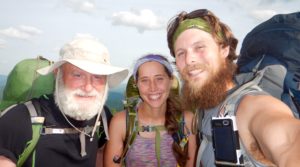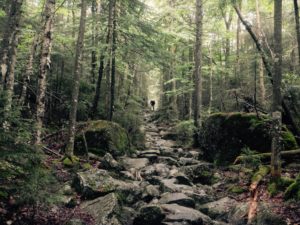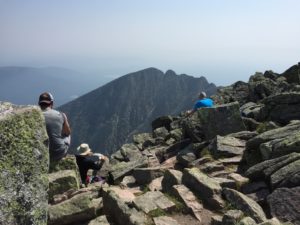Purple Haze, a married mother of four grown women, spent the night a few weeks ago at Cosby Knob, a shelter on the Appalachian Trail in the Smoky Mountain National Park. She woke up to a pouring rain. Members of her trail family, Boots, Highlight, Foxy, Trip, Bear Chaser and others, were cooking breakfast or had already begun to eat. Or were packing up. All of them were thru-hikers, walking from Georgia to Maine, more than 2,000 miles, but no one was in a big hurry to get going that May morning.
Purple Haze headed for the privy, about 50 yards from the shelter and was on her way back when a bear fell in behind her, almost close enough to reach out and touch her, she said.
“When the bear huffed and I turned and saw it I remember thinking, ‘Holy crap, that’s a big bear.'” Purple Haze is close to five feet, nothing tall, not that it mattered much how big she was.
She said she turned around and started to run but her friends were yelling, “Don’t run!”
Purple Haze remembered that she was supposed to look “big and scary and make noise,” not an easy thing to do when a bear is already breathing down your neck, literally. She tried, she said, but the bear wasn’t having it.
“When I turned it was so close I was afraid that it would swipe at me or bite me if I stopped moving. So I just turned back toward the shelter.”
She was almost to the shelter, walking fast, when the bear bit her on the butt.
The other hikers yelled and threw rocks and the bear retreated. But he hung around on a nearby ridge even after one hiker had sprayed it with bear spray.
The bite, which left two puncture wounds, felt like a hard pinch, or a sting, like when you scrape your knee, she said.
“I wasn’t scared at any point that morning – I think it just happened too fast. Everyone kept asking me how I was so calm.”
Purple Haze had been a dispatcher for 15 years, a job where “freaking out” is not allowed, she said. Her husband is a police officer.
The hikers, figuring there was safety in numbers, left in a group.
“Since I wasn’t in serious pain I felt, well, lucky,” she said. “Once we hiked down to the gap and met with all the park folks and the medical personnel at the hospital, it started to sink in exactly HOW lucky I was. Yikes! The following day when we were dropped off at the trailhead, THEN, I thought, ‘Wow, is this a good idea?’ And I hesitated for a few minutes before hiking on.”
And is Purple Haze still on her way to Maine?
She is.
And has she seen any more bears?
She has, two.
“Just a few days later a bear ran down onto the trail in front of me…then turned and looked at me. I banged my poles together and yelled and then it behaved like a ‘normal’ bear and ran [away] from me.
The other one was a baby bear, up a tree. Mother bear was nowhere to be seen, thank goodness.
Why didn’t Purple Haze carry some sort of bear repellant?
She does, she carries pepper spray. But it was in her backpack.
“Unfortunately, I didn’t carry it with me to the privy that day,” she said. “I do now.”
What happened to the bear, the biggest bear one park ranger said he had ever seen in the park?
Park rangers killed him. If a bear attacks a human, and nothing bad happens, it emboldens him, rangers told her.
I know, I know, you’ve been wondering, Why is Purple Haze called Purple Haze? And will she change her trail name to, say, Honey Buns. Or Bear Bait.
She’s Purple Haze because some of her hair is purple. She said she thought about changing her trail name, partly because her initials are B.B., but she’s going to stick with Purple Haze.
One question Purple Haze has been asked repeatedly seems to rankle her.
“I’ve had a huge number of people actually ask me if it hurt when he bit me,” Purple Haze said. “Yep. Sure did.”
Maybe she should ask them, “Duh! Is ice cold?“


